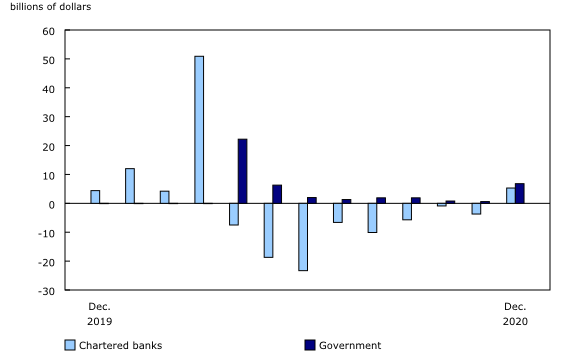Monthly credit aggregates, December 2020
Archived Content
Information identified as archived is provided for reference, research or recordkeeping purposes. It is not subject to the Government of Canada Web Standards and has not been altered or updated since it was archived. Please "contact us" to request a format other than those available.
Released: 2021-02-19
Households end the year with more mortgage debt and less non-mortgage debt
Household sector borrowing is divided into financing in the form of non-mortgage loans, or funds principally for consumption, and mortgage loans, or debt acquired to finance the purchase of a property.
Over the course of 2020, households added over $118 billion to their overall mortgage debt, with year-over-year growth of 7.6% in December. At the same time, sales of existing homes peaked in 2020, despite COVID-19-related restrictions that nearly brought home sales to a crawl in the spring. The cumulative volume of existing home sales in 2020 was 12.6% higher than a year earlier.
Non-mortgage debt declined 1.5% in December compared with the same month the previous year. Unlike with mortgage borrowing, households ended 2020 with nearly $12 billion less in non-mortgage debt than at the beginning the year. December marked the eighth consecutive decline on a year-over-year basis.
Overall, declines in non-mortgage lending partially offset the increase in mortgage debt, as the total credit liabilities of households reached $2,459.2 billion by year-end. Real estate secured debt, composed of both mortgage debt and home equity lines of credit, stood at $1,927.9 billion.
Non-financial private corporations post upswing in borrowing
After a record increase in their outstanding loan liabilities with chartered banks in March 2020, non-financial private corporations recorded eight consecutive months of declining loan balances with this lending sector. However, by December 2020, outstanding non-mortgage loan liabilities with chartered banks had increased by over $5 billion, ending the year with a slight uptick, but balances remained lower than at the end of 2019.
The federal government was the more significant lender in the month, following the expansion of the Canada Emergency Business Account in December. Several hundred thousand businesses received funds in December as part of this program, which contributed to the stock of federal government loans to private non-financial corporations rising by nearly $7 billion.
Overall, total credit liabilities of private non-financial corporations totalled $2,763.9 billion by the end of 2020.
Note to readers
Overview of the monthly credit aggregates
Monthly credit aggregates decompose a portion of the quarterly National Balance Sheet Accounts (NBSA) into the monthly space, providing details on lending to households and non-financial corporations, or the stock of these sectors' outstanding liabilities from the debtor perspective, across a range of credit instruments, including mortgage loans, non-mortgage loans, and debt and equity securities. The aggregates cover all lending sectors including chartered banks, non-bank deposit-taking institutions, other financial corporations, government, and other lenders. The estimates are presented as booked-in-Canada to capture activity within Canada with either domestic or non-resident lenders. Additionally, amounts are reported on an end-of-period basis (i.e., the value of the stock of an asset on the final day of the month). The third month of each quarter is benchmarked to the corresponding quarterly release of the NBSA.
The NBSA are composed of the balance sheets of all sectors and subsectors of the economy. The main sectors are households, non-profit institutions serving households, financial corporations, non-financial corporations, government and non-residents. The NBSA cover all national non-financial assets and all financial asset-liability claims outstanding in all sectors, and similarly, they present stocks as of the end of each quarter.
Estimates are available on a seasonally adjusted basis to improve the interpretability of period-to-period changes in debt. For information on seasonal adjustment, see Seasonally adjusted data – Frequently asked questions.
For more information on the concepts, methodologies, and classifications used to compile these monthly estimates, please see the document Guide to the Monthly Credit Aggregates.
Next release
Data on the monthly credit aggregates for January 2021 will be released on March 19, 2021.
Products
The document "Guide to the Monthly Credit Aggregates," which is part of Latest Developments in the Canadian Economic Accounts (13-605-X), is available.
The document "An overview of revisions to the Financial and Wealth Accounts, 1990 to 2020," which is part of Latest Developments in the Canadian Economic Accounts (13-605-X), is available.
The data visualization product "Financial accounts on a from-whom-to-whom basis, selected financial instruments," which is part of Statistics Canada – Data Visualization Products (71-607-X), is available.
The data visualization product "Distributions of Household Economic Accounts, Wealth: Interactive tool," which is part of Statistics Canada – Data Visualization Products (71-607-X), is available.
The data visualization product "Securities statistics," part of the series Statistics Canada – Data Visualization Products (71-607-X), is available.
The Economic accounts statistics portal, accessible from the Subjects module of our website, provides an up-to-date portrait of national and provincial economies and their structure.
The User Guide: Canadian System of Macroeconomic Accounts (13-606-G) is available.
The Methodological Guide: Canadian System of Macroeconomic Accounts (13-607-X) is available.
Contact information
For more information, or to enquire about the concepts, methods or data quality of this release, contact us (toll-free 1-800-263-1136; 514-283-8300; STATCAN.infostats-infostats.STATCAN@canada.ca) or Media Relations (613-951-4636; STATCAN.mediahotline-ligneinfomedias.STATCAN@canada.ca).
- Date modified:



